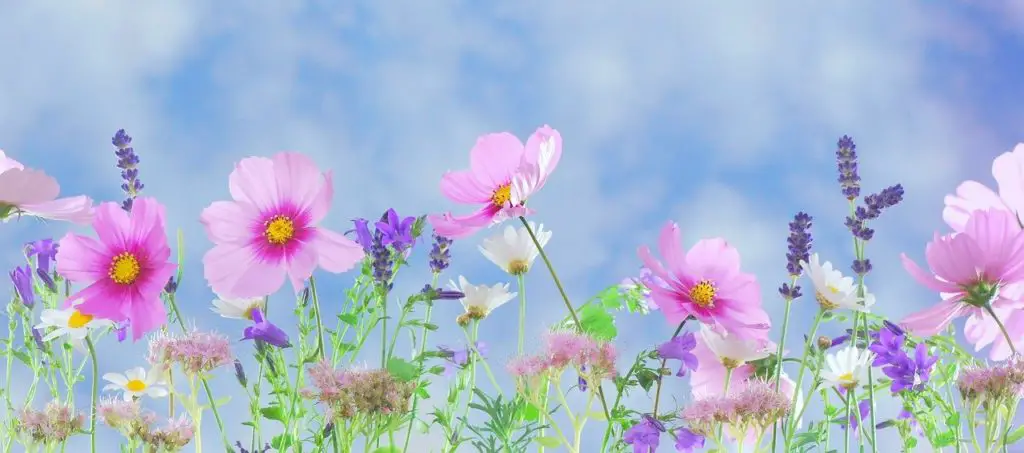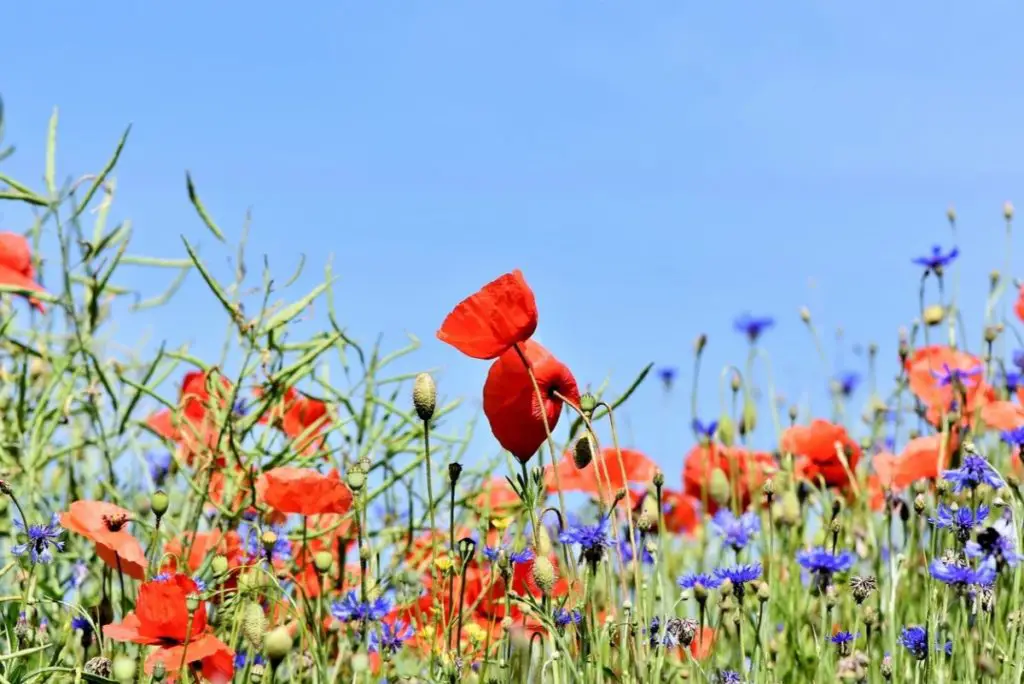Last updated on September 21st, 2023 at 12:38 pm
It’s never been so important to create a bee-friendly garden, bees are responsible for pollinating approximately 75% of flowers and crops in the UK. The best thing about creating a bee-friendly garden is that you get to admire your good work. Bees of all kinds will buzz from flower to flower collecting nectar and pollen to return to the hive.
Creating a bee friendly garden is easy
The first thing I want to make clear is it really isn’t hard to cater for bees in your garden. A few simple changes can make the world of difference to our little friends. As cities expand they replace precious meadows and fields which harbour thousands of bees an many other species alongside. As we’ve destroyed their homes the least we can do is put some effort in to creating a home for them in ours.
So let’s get started on 10 steps to make a bee-friendly garden in the UK…
10 Easy steps to create a bee friendly garden
1. bee organic
If you want your garden to flourish and grow naturally it’s imperative you avoid weed killer and chemical pesticides. It’s a quick fix for the garden but it will have a severe impact on all species inhabiting it. Bees, in particular, are well documented to be suffering from the actinoids contained in modern pesticides.
Skilled gardeners should to try to avoid the use of these chemicals and opt for a natural solution. This can come in several forms and can alleviate the need for any use of chemicals.
Preventative Planting
You can often combat the invader in your garden with some planning and tactics. Planting a secret agent amongst a pack of flowers may deter unwanted guests. You can plant wild garlic in amongst roses to deter and protect the beautiful flowers. Greenfly and Blackfly will consider Tomatoes and Marigolds an unpleasant addition to any garden. All of these add ons will solve some of your problems and the best thing is the bees will love it, taking you one step closer to a bee-friendly garden.
netting
Netting is a great solution to many potential unwanted visitors. Depending on the size, location and type you can deter most insects including birds from attacking your garden.
Organic weed control
Rather than reaching for the chemicals, using a hoe and mulching are great ways to remove weeds. While I recommend leaving some areas for weeds to take their course, using this tried and tested method will ensure a bee-friendly garden.
2. let it grow, let it grow
In the words of frozen, ‘let it grow!’. While a perfectly manicured lawn may be eye-friendly it’s not very bee-friendly. Letting your garden get a little wild isn’t a bad thing and your insect population will skyrocket. A little bit of chaos is a good thing for nature. Holding off on mowing the lawn for a week or two will give pollinators more time to collect the precious resources they need.
Small flowers like clover daises can grow in very little time and are a fantastic source for foraging. Wild plants like Dandelion and Thistle provide endless sources of nectar for many species of bee. A bee-friendly garden isn’t a symmetrical one but if your going in to shock thinking about your pristine lawn, fear not. Why not allocate an area of your garden to developing a great natural habitat for bees, or even better surround that well-mowed lawn with perfect bee-friendly plants that we’ll go over shortly.

3. Get a bee hotel
Bee hotels are perfect additions to bee-friendly gardens. In the United Kingdom, solitary bees like Mason bees are always in need of shelter and protection to raise their young. Ideally situated on the south of your property these wooden constructions can provide warmth for a myriad of insects over the winter months. The bamboo, pine cones and deadwood within all provide perfect habitats for insects in the United Kingdom.
Bee hotels also provide a great educational tool for adults and children. Most hotels come equipped with metal mesh so you can often see the inner workings of the guests. In addition to bees, you’ll also be providing a home for ladybirds and butterflies. With the struggles bees are currently facing due to farming, habitat loss and many other factors it’s never been so important to start promoting bee king at the grassroots.
4. Variety is a good thing
Just like us bees and all the other insects in your garden love variety. Your goal is to create biodiversity in your garden as a whole and keeping the flowers and plants in your garden varied will do the same for your wildlife. Different insects and species of bee target different sources of nourishment, so for the best success grow a range of plants and colourful flowers. This means size as well, aim to have a range of heights to the growth throughout the garden.
5. Plant for the long run
Try to fill your bee-friendly garden with flowers that bloom for a wide range of the year. This will provide a consistent food source rather than feast then famine. In turn this will encourage your gardens residents to stay in the knowledge food and resources are abundant.
A little know trick I discovered tasks you with you watering your plants just as they bloom. This will encourage nectar production and act as a catalyst for the flower in question to produce more. Long blooming plants like perennials and snowberry are perfect choices as they bloom for such a long time.
0
Different species of bee in UK gardens
6. Plant herbs for beepothacary
Just like humans, bees get sick too. Mites commonly spread disease throughout bee colonies in the UK. Lavender contains high amounts of nectar and pollen but it has another huge benefit. When the worker bees return to the nest or hive with their cargo it actually improves the health of the whole colony. It will stop the growth of bacteria and spores within the hive and decrease the chance of disease and infection. Other plants like Oregano and Thyme are perfect for stopping the spread of mites which in turn transport disease around the hive.
7. Create foraging zones
When your planting doesn’t just think about the aesthetics without considering the insects that will be using them every day. For a bee-friendly garden try to plant in large drifts. This means different species in a large group together. This will allow easy access to hundreds of potential nectar sources all in one handy location. Ideally, if you can keep the area around the drift clear it will leave the bees and insects a clear flight path for access. These drifts should be over 1m in an area with easy access.
8. Grab the peat-free compost
Peat bogs provide a habitat for a huge range of insects and bees. As of 2020, the use of peat-based compost has discontinued but as you can imagine there is still plenty around. By not purchasing peat-based compost you actively save a bees habitat alongside thousands of other insects and small creatures.
9. Get bee friendly with nectar and pollen
This step is essential to help the bees and insects in your garden. For a really bee-friendly garden, you need to grow plants that produce large amounts of nectar and pollen. Try to avoid flowers with larger petals because they can create a challenge to access the reward inside.
Ideally, have two nectar/ pollen-rich plants in bloom in any one time, the guide below will show the ideal plants for blooming in each season.
Spring
Lungwort
Dandelion
Dicentra
Crocus
Viburnum
Pussy Willow
Bluebell
Early Summer
Thyme
Sweet Pea
Cat Mint
Holly Hock
Campanula
Comfrey
Allium
late summer
Ivy
Sedum
Cornflower
Buddleia
Honeysuckle
Foxglove
Echinacea
10. Provide A water source
Bees need water just like we do. Water is an essential ingredient in the production of honey at the nest or hive and helps maintain a cool temperature within the colony. You can learn how to make a bee bath here.
Leaving a receptacle out is a perfect way to gather rainwater. Simply place some objects in the pool of water that will not be fully submerged. These little islands will be perfect platforms for the bees to land on and drink safely without the risk of going for a swim. If you already have a pond in your garden try adding some rocks around the perimeter or floating leaves like lily pads.
Sit back, relax and enjoy
You’ve done all the hard work and your garden is buzzing with all kinds of life. There is nothing more satisfying than knowing your hard work and commitment has paid off. You will see the results everywhere as pollinators browse from flower to flower with ease collecting nectar and pollen to store and consume.





